Mikimoto Baroque Pearl Necklaces: History and Craft
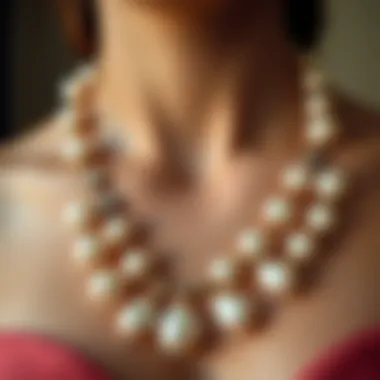
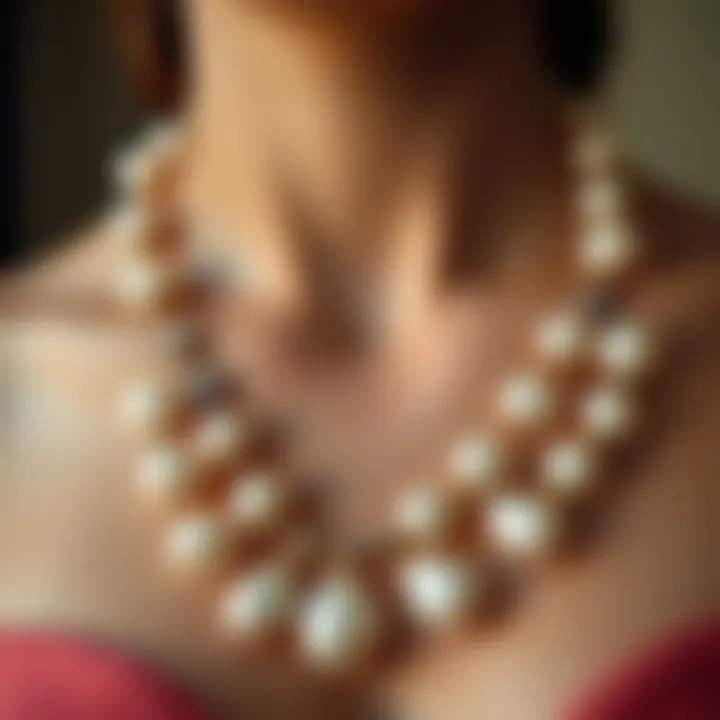
Intro
Mikimoto baroque pearl necklaces are not just merely pieces of jewelry; they encapsulate an exquisite blend of nature's artistry and human craftsmanship. With a history rooted deeply in the essence of luxury and timeless elegance, baroque pearls possess unique characteristics that set them apart from their more conventional counterparts. The irregular shapes, unique luster, and soft, iridescent hues contribute to the charm that captivates both collectors and jewelry enthusiasts alike.
In this article, we will journey through the origins of Mikimoto pearls, tracing back to the remarkable vision of Kokichi Mikimoto. His pioneering efforts in cultivating pearls in the late 19th century laid the foundation for what would become a revolution in luxury adornments. We will delve into the craftsmanship involved in creating baroque designs, as each piece is meticulously fashioned to highlight the innate beauty of the pearls. The cultural impact of these necklaces in the realm of high fashion and luxury will be examined, revealing how they have not only adorned necklines but have also made significant statements throughout various eras.
Furthermore, the article will provide practical insights into maintaining these necklaces and considerations to keep in mind when purchasing. By weaving these threads together, we seek to present a comprehensive guide that resonates with gemstone enthusiasts, collectors, and jewelry designers alike. The richness of Mikimoto baroque pearls goes beyond their appearance; they offer a narrative steeped in history and tradition, which we will explore in depth.
Gemstone Overview
Description of the Gemstone
Mikimoto baroque pearls are truly a marvel of nature. Unlike the classic round pearls, baroque pearls exhibit a variety of shapes—from oval to drop-like and even uniquely contorted forms. It is their irregularities that make them distinctively beautiful; no two baroque pearls are identical. The outer layer, known as nacre, gives them a rich depth and luster, often reflecting a spectrum of colors depending on the angle of the light. This sublime surface is a result of the cultivation process, which involves careful nurturing and harvesting from the Akoya oyster.
Physical Properties
When talking about the physical properties, baroque pearls typically range in size from 6 mm to 15 mm, with some extraordinary examples reaching up to 20 mm. The surface may exhibit natural blemishes or inclusions, adding to their charm. In addition, the weight of these pearls varies widely, as the irregular shapes can lead to a range of densities. The refractive index is generally between 1.53 to 1.68, contributing to their extraordinary sheen.
“Mikimoto pearls represent a harmonious alliance between the sea's beauty and human creativity.”
Mikimoto's dedication to quality means that these pieces not only serve as adornments but are also considered heirlooms. Carrying a Mikimoto baroque pearl necklace is like wearing a fragment of nature combined with expert craftsmanship. This connection makes them treasured pieces that often find a place within families for generations.
Cultural Significance
The global fascination with pearls can be traced back several centuries. Once considered symbols of wealth and status, these stones have evolved, transcending simple luxury to embody cultural significance. Mikimoto's baroque pearls, in particular, have found their niche in the high-fashion realm, adorning the likes of celebrities and influencers.
As we journey further, we will address how these timeless necklaces cater to the aesthetics of various cultures while also maintaining their luxurious allure, transforming how these exquisite gems are perceived and appreciated worldwide.
In the next section, we will explore the intricate craftsmanship required to produce these masterpieces, shedding light on the artistry behind each necklace.
Preamble to Mikimoto Pearls
Mikimoto pearls are not just any gemstones; they represent a remarkable blend of artistry, elegance, and historical significance in the world of fine jewelry. The introduction to Mikimoto pearls sets the stage for understanding the nuanced details of their artistry and the craftsmanship that goes into making each piece unique. Whether you're a seasoned collector, an aspiring jewelry designer, or simply a gemstone enthusiast, knowing about Mikimoto pearls can enrich your appreciation of these opulent adornments.
For those who might not know, Mikimoto is synonymous with luxury. Founded by Kokichi Mikimoto in the late 19th century, it's recognized globally for pioneering the cultured pearl industry. This company has transformed the perception of pearls from mere organic materials to luxurious status symbols worn by royals and celebrities alike. Through this exploration, the reader will gain insights into why Mikimoto pearls continue to remain a desirable commodity in contemporary fashion.
Beyond their undeniable beauty, the significance of Mikimoto pearls in jewelry making cannot be overstated. They not only embody wealth and sophistication but also reflect the meticulousness of the artisans behind the scenes. Understanding their historical context and significance offers a clear lens through which one can appreciate the intricate craftsmanship behind every pearl necklace.
In this journey, we will uncover:
- The historical background that shaped the Mikimoto brand into the global powerhouse it is today.
- The significance in jewelry making, emphasizing how these pearls contribute depth and distinction to any collection.
- The intricate craftsmanship involved in baroque designs, ensuring each piece is one-of-a-kind.
This introduction aims to ignite curiosity, encouraging readers to delve deeper into the world of Mikimoto pearls and their timeless allure.
Historical Background
Kokichi Mikimoto's story is woven into the very fabric of pearl culture. Born in Japan in 1858, his vision was not only to cultivate pearls but to create a pearl necklace that would dazzle the world. It’s worth noting that prior to his innovations, the realm of pearls was largely dominated by natural finds, which were both rare and limited in supply. Mikimoto changed all that by mastering the art of cultured pearls in 1893. This groundbreaking discovery led to the establishment of the first cultured pearl farm in Japan, forever altering the landscape of pearl jewelry.
Mikimoto’s quest wasn’t without its challenges. He faced skepticism from traditionalists who believed that only natural pearls held value. However, his relentless dedication paid off. By 1907, Mikimoto’s pearls dazzled onlookers at the St. Louis World's Fair, elevating the status of cultured pearls internationally. This not only bolstered his reputation but cemented Mikimoto’s legacy as the "Pearl King."
As the years rolled on, Mikimoto’s emphasis on quality and craftsmanship paved the way for luxury pearl jewelry that is still sought after today. Each piece from Mikimoto is a testament to a rich history, carrying with it an essence of artistry that goes beyond mere ornamentation.
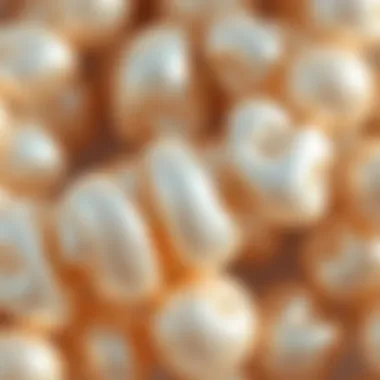

Significance in Jewelry Making
The significance of Mikimoto pearls in jewelry making lies not just in their aesthetic appeal, but also in the story they tell. The transformation of simple marine elements into breathtaking pieces of art illustrates meticulous attention to detail. Craftsmen take into account various factors such as luster, surface quality, and shape, which brings out the true essence of these pearls.
Mikimoto's commitment to excellence sets a benchmark for the entire industry. Each necklace is crafted with skilled hands and innovative techniques, ensuring a blend of tradition and modernity.
Consider the following aspects that highlight their importance:
- Cultural Symbolism: Often seen as symbols of purity and elegance, Mikimoto pearls have been worn during significant life events, such as weddings and graduations, making them treasures passed down through generations.
- Artisan Techniques: The craftsmanship involved in constructing Mikimoto necklaces goes beyond just stringing pearls. Techniques like stringing and knotting ensure durability while enhancing the visual appeal,
- Innovative Designs: Mikimoto evolves with the times, incorporating contemporary influences while maintaining the classic aesthetic that has defined its brand for over a century.
Mikimoto pearls are not merely accessories; they are expressions of art and history. Understanding their significance in jewelry making adds depth to their allure, transforming them from mere adornments into meaningful heirlooms.
Understanding Baroque Pearls
Mikimoto baroque pearls are hallmark treasures in the world of jewelry, offering an exquisite look into the artistry of nature and human creativity. Their irregular shapes and unique characteristics set them apart in a marketplace dominated by round pearls. Understanding baroque pearls is essential for anyone passionate about jewelry, be it collectors, designers, or simply those who appreciate fine adornments. This section peels back the layers of what makes these pearls special, how they are formed, and why they are a significant focus within the Mikimoto brand.
Definition and Characteristics
Baroque pearls have a distinct definition; they are pearls that exhibit an irregular shape, often lacking the spherical perfection of traditional pearls. This uniqueness stems from the natural environment in which they develop. These pearls come from the oyster's capacity to create nacre in varying patterns, leading to intricate, often asymmetrical forms.
In terms of characteristics, baroque pearls can present a range of colors, from pure white to deeper shades of gold and even rare hues like lavender or black. Their surface texture often varies as well, with creases and unique markings that tell a story of their creation. The luster of these gems tends to be remarkable, providing an enchanting glow that captures the eye. Additionally, one of their most appealing aspects is their organic shape, which brings character to each piece of jewelry that showcases them.
Notably, Mikimoto baroque pearls are renowned for their top-tier quality, showcasing the brand's commitment to excellence in harvesting and processing these natural wonders. Each pearl tells not just its story but also serves as a reminder of the ocean's artistry, making them a desired choice for necklaces that aim to merge nature with elegance.
Comparison with Other Pearl Types
To truly appreciate baroque pearls, it's essential to compare them with other types of pearls, such as Akoya, Tahitian, and South Sea pearls.
- Akoya Pearls: These are known for their perfectly round shape and high luster, making them a popular choice for traditional pearl strands. Unlike baroque pearls, which embrace their imperfections, Akoya pearls epitomize classical elegance with their uniformity.
- Tahitian Pearls: Hailing from French Polynesia, Tahitian pearls are celebrated for their dark colors and exotic overtones. While they can exhibit some baroque shapes, they are often more consistent compared to fully formed baroque pearls. Their unique color spectrum provides an alluring contrast in pearl jewelry.
- South Sea Pearls: Larger in size, South Sea pearls are primarily white or golden and are valued for their size and cashmere-like texture. They offer a more rounded option but lack the distinctive artistry found in baroque pearls.
"Baroque pearls, with their imperfections, are a testament that beauty often lies in uniqueness. They are a tale of individual stories, something that resonates with many collectors and jewelry lovers."
Craftsmanship Behind Mikimoto Baroque Necklaces
The craftsmanship found in Mikimoto baroque pearl necklaces is akin to a finely-tuned orchestra, where each element plays a crucial role in creating a harmonious masterpiece. This section dives into the specific techniques and innovations that make these necklaces not just jewelry, but statements of artistry and elegance. Every detail, from stringing to design innovations, contributes to the overall allure and significance of these exquisite pieces.
Artisanal Techniques
Stringing and Knotting Methods
The stringing and knotting methods utilized in Mikimoto baroque pearl necklaces serve more than just a functional purpose. These processes are part of a time-honored tradition that enhances both the beauty and durability of the jewelry. The key characteristic of using silk thread is that it gives a soft, luxurious feel while also providing strength. Silk is less likely to stretch or break compared to other materials, ensuring the pearls remain securely fastened.
A unique feature of this method is the hand-knotting between each pearl. This technique not only adds an element of safety—preventing other pearls from scattering in case of a break—but also creates an elegant drape. One might argue this attention to detail is what distinguishes high-end pieces from generic offerings.
However, there can be downsides. Hand-knotting is labor-intensive and time-consuming, leading to higher costs. Yet, for those who value meticulous craftsmanship, it’s well worth the investment. In sum, the stringing and knotting methods are not just technicalities; they significantly contribute to the overall aesthetic and functional integrity of Mikimoto pearls.
Setting Techniques
Setting techniques in the art of Mikimoto necklaces also deserve attention. The way the pearls are arranged—often in asymmetrical patterns—infuses a modern flair while paying homage to their organic forms. A notable attribute of the setting technique is its adaptability; it allows for a play between the pearls’ unique shapes and the design envisioned by the jeweler. This adaptability makes it a popular choice for both traditional and contemporary jewelry aesthetics.
Moreover, the use of platinum or gold for the settings accentuates the luster of the pearls. By creating a visual contrast with the baroque shapes, these metals enhance the overall richness of the piece. The benefits of this technique are manifold—it doesn’t only enable a secure fit for the pearls but elevates the design, allowing for exquisite detailing.

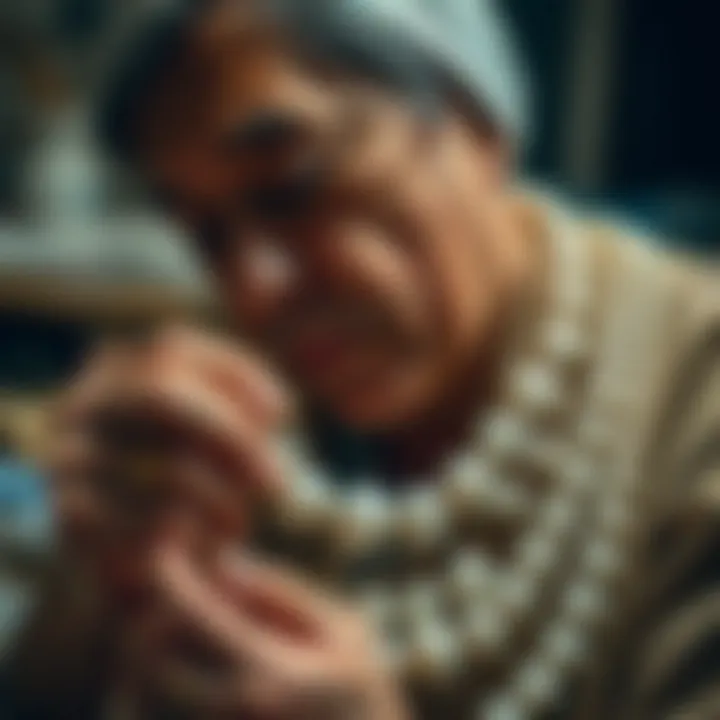
However, one must consider that these high-quality materials can increase the price of the necklace. While this might deter some, those passionate about jewelry recognize that quality often comes at a premium. Ultimately, setting techniques play a vital role in the artistry of Mikimoto baroque necklaces, uniting form with function in a visually stunning execution.
Design Innovations
Influence of Contemporary Trends
The influence of contemporary trends on Mikimoto baroque pearl necklaces cannot be overstated. Modern design often embraces minimalism and unique, asymmetrical shapes, which complements the transformative nature of baroque pearls. This distinctive style possesses a certain allure that attracts both traditionalists and trendsetters alike.
One of the key characteristics of this influence is the intentional play of colors and textures. Designers often incorporate colored glass or gemstones to create visual dynamics that set the baroque pearls apart. This approach not only makes the necklace attractive but also opens the door for customization, making each piece feel bespoke.
Still, one should be cautious of passing trends. While the integration of modern elements can breathe new life into classic designs, it risks overshadowing the intrinsic beauty of the pearls themselves. The challenge lies in balancing contemporary flair without losing the essence that makes Mikimoto pearls timeless. It’s a delicate dance, yet those who successfully navigate it create some of the most captivating jewelry around.
Timeless Aesthetic Choices
Timeless aesthetic choices underscore the enduring appeal of Mikimoto baroque pearl necklaces. The design principles drawn from classical art and nature often evoke a sense of nostalgia while remaining fresh. A notable attribute of such designs is their ability to transcend generations, remaining relevant regardless of shifting fashion currents.
The unique feature of these aesthetic choices lies in their versatility. Pearls are inherently adaptable, allowing for varying levels of formality in a design. Whether donned at a gala or worn casually, these necklaces can transition effortlessly, appealing to diverse tastes. The added value of these designs is clear; they represent not only a wearer’s style but also an investment in lasting beauty.
Cultural Impact of Mikimoto Necklaces
Mikimoto baroque pearl necklaces hold a significant place not only in the realm of luxury jewelry but also in cultural contexts. These necklaces represent artistry, tradition, and the enduring allure of pearls in various societies. The cultural impact of these necklaces extends beyond aesthetics, touching on themes of femininity, status, and timeless beauty. This section seeks to unpack how Mikimoto's creations resonate across different cultures and historic timelines.
Symbolism of Pearls in Various Cultures
Pearls have long been synonymous with various meanings in cultures around the world. In many societies, they are seen as symbols of purity and wisdom. For instance, in ancient China, pearls were often associated with the moon and regarded as gifts from dragons. These precious gems were considered to bring harmony and protection. Similarly, in some Middle Eastern cultures, pearls symbolize wealth and prosperity. Wearing such adornments was akin to wearing one's social status.
The Mikimoto brand, by embracing the baroque pearl's unique irregular shapes, reinterprets this symbolism. Unlike traditional round pearls, baroque pearls convey individuality and the beauty inherent in imperfections. This new perspective adds a layer of meaning, suggesting that imperfection can also be precious—echoing the idea found in the Japanese aesthetic of wabi-sabi, which finds beauty in the transient and imperfect.
Historic Moments in Pearl Fashion
Throughout history, pearls have made indelible marks in fashion trends. In the 17th century, the popularity of pearls peaked in Europe, especially during the reign of Queen Elizabeth I, who famously draped herself in endless strings of pearls.
Fast-forward to the 20th century, Mikimoto changed the game. His cultured pearls became a part of modern luxury, leading to iconic moments like when actress Audrey Hepburn wore a Mikimoto pearl necklace in Breakfast at Tiffany's. This moment not only cemented the brand in Hollywood history but also nudged pearls into the contemporary fashion dialogue.
In the current day, baroque pearls have regained attention, thanks in part to designers who incorporate them into minimalist and artistic designs. They are celebrated for their organic forms, allowing wearers to express their personal style in new ways. The revival of baroque pearls mirrors greater cultural trends towards authenticity and individual expression, positioning Mikimoto necklaces not just as jewelry but as statements of identity.
"Mikimoto baroque pearls advise to embrace the unusual, for beauty often lies where one least expects it."
As we stand at the intersection of tradition and modernity, it becomes clear that the cultural narrative surrounding Mikimoto baroque pearl necklaces is rich and layered. Their significance stretches from ancient symbolism to contemporary fashion, continually evolving while remaining rooted in their cultural heritage.
Care and Maintenance of Baroque Pearl Necklaces
Mikimoto baroque pearl necklaces, with their unique shapes and luster, hold a special charm for collectors and enthusiasts alike. However, these beautiful creations require careful attention to maintain their allure. Regular care and maintenance are essential to preserve the integrity and brilliance of these pearls. Without proper attention, the effects of dirt, moisture, and even the natural oils from your skin can dull their enchanting surface, diminishing their splendor over time.
Taking steps to care for these precious items not only enhances their longevity but also ensures that their beauty shines through in every occasion. Here's a closer look at how you should treat these valuable treasures.
Cleaning Techniques
When it comes to cleaning baroque pearls, it's crucial to approach the task with gentleness. Harsh chemicals and abrasive cloths can lead to permanent damage. A simple cleaning routine can keep them looking pristine. Here’s how to go about it:
- Soft Cloth Wipe: Regularly wipe the pearls with a soft, lint-free cloth after each wear to remove body oils, dust, or any product residue such as perfumes or lotions.
- Mild Soap Solution: For deeper cleaning, mix a few drops of mild soap, like baby shampoo, with lukewarm water. Dip a soft cloth into the solution, then wring it out so it’s damp, not wet. Gently wipe the pearl surface. Never soak the pearls!
- Rinsing: After cleaning with soap, it's good practice to rinse the pearls carefully under running water. However, avoid strong water pressure as pearls can get damaged.

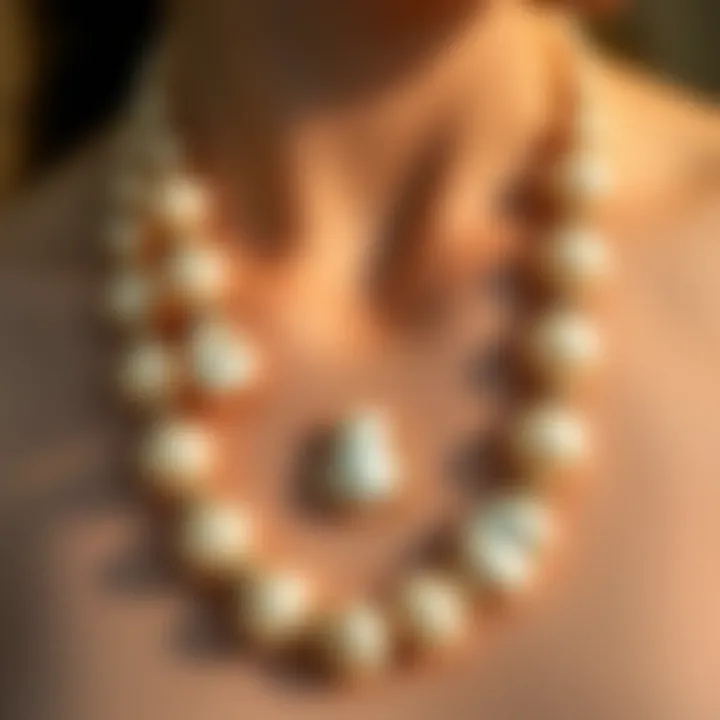
"Pearls are alive, requiring care and tenderness to showcase their timeless beauty."
- Drying: Always use a clean, dry cloth to gently pat the pearls dry after cleaning. Never use a hairdryer or place them in direct sunlight to dry, as this can cause irreversible damage to the material.
Storage Recommendations
Storing your Mikimoto baroque pearls properly is a vital step in ensuring their preservation. These necklaces should not be treated like your standard jewelry pieces. Here are some recommendations:
- Keep Them in Soft Pouches: Store each individual pearl necklace in a soft, breathable pouch or lined jewelry box. This prevents them from scratching against other jewelry or each other.
- Avoid Plastic Bags: While it may seem convenient, plastic bags can actually trap humidity, leading to potential damage and deterioration in quality over time.
- Temperature Control: Store them in a cool, dry place; extreme temperatures or humidity changes can negatively affect the pearls’ surface quality.
- Separate from Other Jewelry: It’s advisable to keep these necklaces away from hard or sharp-edged items that could cause scratches.
Taking the time to clean and store your Mikimoto baroque pearl necklaces with care will yield benefits that far outweigh the effort. By maintaining their beauty and integrity, the investment in these gems is safeguarded for generations to come.
Purchasing Considerations
When it comes to acquiring a Mikimoto baroque pearl necklace, making an informed decision is critical. This section delves into the key factors to ponder before making such a significant investment. Understanding quality indicators and market dynamics can empower buyers and foster more gratifying purchases.
Evaluating Quality
Lustre and Surface Quality
A pearl's lustre signifies its essence—a shiny surface that reflects light like a thousand shimmering stars. The quality of lustre can vary, but in Mikimoto baroque pearls, this characteristic stands out. High-quality lustre often translates to a more vibrant and alluring appearance. The glossy sheen can evoke emotions and symbolize elegance in ways lesser-quality pearls simply can't.
However, it’s not all about high reflectivity. Surface quality also plays a pivotal role. Flaws can diminish the value of a pearl, so paying attention to the nacre, or outer layer, is vital. Mikimoto’s craftsmanship usually assures an impeccable surface, but viewers should still inspect for blemishes or irregularities, as they can detract from its beauty. A pearl with a smooth surface might command a higher price, yet it also guarantees longevity and timeless appeal in adornment.
Size and Shape Variability
Mikimoto baroque pearls defy uniformity, as these pearls present a unique tapestry of shapes and sizes. This variability is a characteristic feature and is often celebrated. Each piece is a testament to natural artistry, resulting in something one-of-a-kind. Larger pearls typically fetch higher prices, yet smaller pearls can often be equally stunning depending on their lustre and color.
In essence, larger pearls can make a grander statement in neck-wear, while variations in shape can offer an artistic flair to jewelry designs. These irregular forms create a sense of movement and individuality, quite unlike the symmetry found in traditional round pearls. Hybrid pieces combining different sizes and shapes can also give a more dynamic feel to any necklace, which can be both a strength and a weakness when evaluating your place in the market.
Price Factors
Market Demand
The demand for Mikimoto baroque pearls fluctuates based on trends in the jewelry market. They have garnered a following due to their uniqueness, often seen as luxurious yet accessible to discerning buyers. This demand can affect pricing dramatically—the more people desire a particular style or type of pearl, the higher the price tends to climb. It’s crucial for buyers to keep an ear to the ground regarding current trends, as overlooking market changes can result in overpaying for a necklace that may later lose its allure.
For instance, during certain seasons, colors or shapes may surge in popularity, directly influencing availability and cost. Buyers should be strategic about their purchases, possibly waiting for the right moment to buy rather than jumping at the first opportunity. Recognizing the cyclical nature of demand can be a beneficial tactic.
Brand Reputation
Mikimoto is synonymous with quality in the pearl industry. The brand’s reputation acts as a significant influencer on price, serving as a seal of trust and assurance. When you're looking at Mikimoto pearls, you are not just buying a piece of jewelry; you're investing in a legacy of craftsmanship and history.
Intriguingly, other brands may offer baroque pearls, but none hold the same standing as Mikimoto. This creates a unique market dynamic where the brand name itself can command a premium. Yet, while this reputation ensures a level of quality, it might also deter some potential buyers who feel intimidated by the price tag. The balance here lies in recognizing that with Mikimoto, the price often reflects not just the material, but the artistry and expertise behind the piece.
- In summary, understanding these purchasing considerations can guide potential buyers toward making choices that align with their aesthetic preference and budget expectations while also acknowledging market trends and brand values.
Culmination: The Lasting Allure of Mikimoto Baroque Pearls
As we wrap up our exploration of Mikimoto baroque pearl necklaces, it's evident that these exquisite pieces hold a distinct place in the realm of jewelry. The themes of artistry, history, and cultural significance interweave to create a rich tapestry that appeals to both collectors and those with a keen eye for beauty.
Reflections on Craft and Elegance
The craftsmanship behind each Mikimoto baroque pearl necklace is not merely a matter of assembling pearls; it's an intricate dance of art and dedication. Mikimoto pearls, with their irregular shapes and varied luster, encapsulate nature's unpredictability, making each necklace a unique work of art. The careful selection of each pearl reflects the brand's commitment to quality—a badge of honor in the jewelry community.
- Artisan Techniques: Crafting baroque pearls requires a deft hand and an artistic vision. From stringing and knotting methods to the meticulous setting techniques, every step is a testament to the jewelry maker's skill. These artisans blend traditional practices with contemporary innovations, thereby ensuring that each piece is not just worn but experienced.
- Cultural Symbolism: Throughout history, pearls have been a symbol of purity, elegance, and sophistication in various cultures, and Mikimoto baroque pearls amplify that symbolism. They embody a connection to heritage, depicting stories from both the Japanese culture and global fashion narratives. Such significance elevates the emotional value of each necklace, making it more than an accessory.
- Timeless Appeal: While fashion trends come and go, the elegance of Mikimoto baroque pearls stands the test of time. Their ability to complement both casual and formal attire makes them versatile, allowing wearers to express their personal style effortlessly. In a fast-paced world of changing trends, the enduring elegance of Mikimoto baroque pearls keeps them relevant and sought after.
In summary, Mikimoto baroque pearls encapsulate more than mere adornment. They symbolize a commitment to craft, a respect for history, and a celebration of individuality. As we gaze upon these shimmering gems, we recognize not just their aesthetic merits but also the deeper layers of meaning they hold. This artistry is what makes Mikimoto baroque pearl necklaces not only timeless treasures but also tangible connections to a rich legacy.







